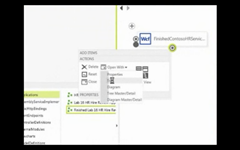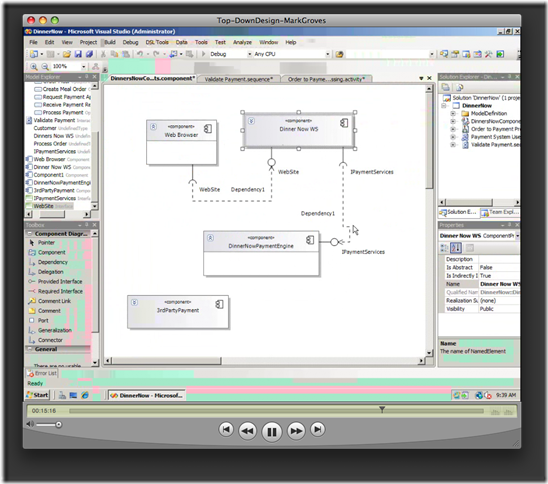(Find his answer here)
Dear Douglas Purdy,
Over the last several months I followed the development around “Oslo”. I couldn’t attend the PDC, but I watched all Oslo videos, read a lot of the reactions, and also spent some hands-on time writing a few schemas and grammars.
The subject I want to write to you about is particularly your talk A Lap around “Oslo” at PDC as well as your post What is Oslo?.
I’ll just quote some of your spoken and written words and put my comments below. Just for easier referencing I’ll group them in sections.
Feel free to answer on your blog in order to avoid endless comments. I suggest using the tag “Oslo2EMF”.
1. Preamble
I’ve been developing using Microsoft technologies for 7+ years now. I’m absolutely positive to Microsoft and I love .NET. Nothing here is intended to be disparaging about Microsoft.
We have realized that we live in a model-driven world.
Compared to the Java and Eclipse camps, I’d say, you realized that quite late, but still welcome and congratulations. Talking about models and particularly model-driven software development, they seem to be far ahead in both methodology and technology (more later). In a way MS also acknowledged this, by joining OMG [1]* after kind of criticizing it for a couple of years.
* see link index below for all following links
2. Terms
Now when we talk about models, and one of the things we talk about particularly with modeling inside of Microsoft, particularly with Oslo, is this notion of a very key term that I like to get across, which is Model-driven Development, Model-driven Software Development.
If you want to upset the community, just take an established term “B”, rename it to “A”, and then reinvent something slightly different branding it “B”.
My Point is that MDSD is an established term in the community. It has already been defined and there are several books available [2].
The term MDSD – as the community uses it – has its roots back in the OOPSLA in 2003 [3]. Many of the attendees did MDSD before that, but they didn’t have a term that wasn’t trademarked (as MDA, MDD are). – Prove me wrong!
“This” MDSD stands for using models in the software creation and building process. In most cases this is done using code generation frameworks such as oAW[4] or androMDA[5].
In the Microsoft world MDSD was almost unheard [6], but Software Factories and the DSL Tools, as well as some Visual Studio built-in designers could be grouped into that category.
Now, in your talk, you renamed that approach to “model-assisted”. I think this is an appropriate term and I also understand your next point about “model-driven” in the sense of models directly executed by runtimes. But in that sense, “driven” means to drive applications and runtimes, not the development process.
To make my point: Please don’t call executing models MDSD. I think Model-driven Applications, as you also call it sometimes and as written on the slides (14:50), too, is more adequate.
3. Runtimes vs. Code Generation
To stick to your terminology, you said model-assisted development is a great way of creating software today. I do totally agree with that.
And you see some great examples on that on the slide. One of the canonical ones is HTML.
You are right. HTML is a model which is driven by several runtimes and it’s even openly specified. But it’s also an great example of how hard it is to write runtimes – All browser vendors struggle – I guess, I don’t have to say more here.
Another “great” example is the Windows Workflow Foundation. I like it. I even gave talks on it. Microsoft did well, but not good enough. They have to rewrite the runtime, the tools, …
Textual DSLs – I tell you this thing is hot!
Exactly! I totally agree, and I love MGrammar.
Q: “10x more productive with Oslo than with their current set of tools” to do what?
A: To write an .net application.We are giving you mservice, mweb, etc.
You can, of course, write your own DSL, but we think that that will be the province of mainly ISVs and people that write frameworks today.
I totally disagree. Do you really mean what you’re saying?
DSLs are broadly used in projects, not only frameworks. You’ll miss quite a bunch of (growing) audience, if you focus only on ISVs. Big companies do big projects. And there is written millions of lines of code in such projects. MDSD, already today, boosts productivity in such projects – not 10x, but still a lot. [9]
I don’t say, runtimes are bad. But it is just not realistic to create runtimes for everything you want to base on models.
One of the reasons code-generation has so bad reputation – especially in the MS world – is because it’s often too ugly. When I talk about code generation, I mean generating well-structured, nice formatted high-quality code.
For now, Microsoft’s only answer to code generation is T4. Nice, but usually it leads to ugly code. It doesn’t even support creating multiple files for different classes.
What do you think? Do you have any plans on leveraging a code generation framework?
4. Open Microsoft and the Eclipse Modeling Project
Early, open and often. This is Pre-Pre-Pre Alpha, its raw. We want to get your feedback.
Love it!
M will be released under the Microsoft Open Specification Promise(OSP)
Does it mean, the source code will be published as a reference implementation, too? And what is M? MGrammar, MGraph, MShema, MWeb, MService, …? Will the mapping to the repository, and the definition of the repository be opened?
Anyone can implement it. We want this approach wide spread on a variety of different platforms. We want it to be as broad as Xml is today.
Quite ambitious. Where is the standards consortium, then? What about JSON?
We want to engage, particularly with the Open Source Community, in order to make sure that we can invent the future together.
I’m quite interested in what that engagement could be like, when it comes to investing effort or money.
Are we going to do anything to build a bridge to EMF, ehm, the answer is: …. ehm, we will see.
The key thing is: What I’d love to see is, I’d love to see the Eclipse Model Project, I’d love to see that community to come up with a bridge for this. So that’s part of the open – I’m not kidding.
So if they want to develop a bridge for this, absolutely I’m going to support doing that. That’s one of the key reasons we do the OSP.
I’d love to see an Eclipse “M” Project. I’d love it.
Could somebody quote me on that, so we can get that ball rolling?
Quoted. So now lets get the ball rolling. We’ve got two points here. Who is “that community”, and what kind of “bridge” do you mean?
I don’t think, Eclipse just throws their well tested products away in order to use “your” pre-pre-pre-alpha code. Asking Eclipse to implement “M”, at the first glance, sounds arrogant and kind of ridiculous to me.
But, being open, lets imagine EMF was a place and we want a nice bridge to and from Oslo.
Of course there will be the feeling of competition…
But in the end, the success of modeling is the most important thing.Ed Merks, EMF project co-lead
Where to build the bridge? And what to archive with it?
- EMF (Ecore) <-> MGraph/MSchema
If you understand both models on both sides, you’ve won alot. But mapping the schemas to Ecore could be a hard issue. EMF uses explicit inheritance, while MSchema uses structural subtyping. But still, it could be done. - xtext <-> MGrammar
Both languages transform unicode to semantic models. The concepts match, while the syntax is quite different. - TBD, T4? <-> openArchitectureWare
When it comes to code generation, M2M transformations and model checks, as said before Microsoft doesn’t offer anything even approaching openArchitectureWare.
I think the people you should get involved with are Ed Merks (EMF co-lead and Ecore-developer) as well as Sven Efftinge(xtext and oAW Project lead), Markus Völter (xtext, oAW) and Peter Friese (xtext, xtend, oAW). [7]
Could you imagine an open space conference on this collaboration? You say “I’d love it” so often that I have to ask, how much would you love it?
Sincerely yours,
Lars Corneliussen
Links Index
Since this is a letter, I didn’t want to confuse it with links. So I indexed them and put them below.
- [1] OMG
Microsoft Web Platform – Microsoft Sets Modeling Strategy, Joins OMG
Why Microsoft thinks MDA and UML are too general - [2] Books on MDSD
Amazon.com: model-driven software development
Amazon.com: Model-Driven Software Development: Technology, Engineering, Management: Thomas Stahl, Markus Voelter, Krzysztof Czarnecki - [3] OOPSLA
2003: Generative Techniques in the context of Model Driven Architecture
2004: Best Practices for Model-Driven Software Development - [4] openArchitectureWare
openArchitectureWare.org – Official openArchitectureWare Homepage - [5] androMDA
AndroMDA.org – Home - [6] MDSD with .NET
DSL Tools, Software Factories and Oslo – Model-driven the Microsoft .NET way - [7] EMF Community
Eclipse Modeling – Meet The Team- Ed Merks
Modeling PMC Co-lead, EMF/EMFT PMC, XSD Lead
Macro Modeling and partner of itemis AG
Ballantrae, Ontario, Canada - Sven Efftinge
TMF PMC, M2T Committer, MWE Committer
itemis AG
Kiel, Germany - Markus Voelter
MWE Comitter, M2T Comitter
Independent
Göppingen, Germany - Peter Friese
TMF Committer, M2T Committer, MWE Committer
itemis AG
Kiel, Germany
- Ed Merks
- [8] Xtext – Eclipsepedia
- [9] Advantages of Model-driven Software Development
Advantages – Model-Driven Software Development – Portfolio – itemis AG
Model-Driven Software Development – Portfolio – itemis AG













